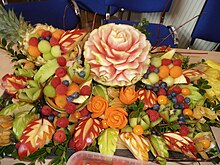Just this week, I saw a few fruit cravings in my Face Book Page celebrating the Chinese Lunar Year- the Year of the Dragon. Thus I was curious on the history of this ancient art. I did some search and here's what I learned.
Fruit carving is the art of carving fruit, a very common technique in Europe and Asian countries, and particularly popular in Thailand, China and Japan. There are many fruits that can be used in this process; the most popular one that artists use are watermelons, apples, strawberries, pineapples, and cantaloupes.
History
China
Many believe that fruit carving originated in China during the Tang Dynasty, which lasted from AD 618-906. Fruit carving in China usually features legendary creatures, and animals. Not only is fruit carving used in cultural and traditional ceremonies, but also ordinary households are known for decorating plates with fruit carvings when they have guests over. Specifically, watermelon carving has been and still is very popular in China. Usually, the outside of the melon is carved on and the melon pulp is scraped out of the inside of the melon, so it can be used as a container to put food or flowers in. Chinese fruit carving is used to tell their legends and stories.
Europe
Fruit carving is included in Matthias Giegher's 1621 work Il Trinciante ("The Carver"), where he describes carving oranges and citrons into abstract patterns, shell-fish, four-legged animals and the Habsburgs' double-headed eagle, but the art was not common in Europe or North America until the 1980s when several books on the topic were published.
Thailand

Fruit carving is a significant part of Thai cultural heritage. Watermelon carving dates to the 14th century in Thailand during the Sukhothai dynasty. The annual Loi KrathongFestival occurs each November where people in Thailand float lamps and lanterns down a river to honor water spirits. One legend is that one of the king's maids decorated her lantern with a watermelon carved with flower designs to impress him and that he was so pleased that he encouraged all Thai women to adopt the practice. The king also requested that fruit carving become part of the primary school curriculum. Thailand fruit carving features flowers, birds and floral patterns.
Japan
The Japanese emphasize the presentation of a dish and how the plate aesthetically appeals to others. Fruit carving in Japan is referred to as Mukimono. Mukimono began in ancient Japan in an effort to make dishes more appealing since the food was placed and served on an unglazed pottery plate, which had a rough look to it. Chefs would cover the plate in leaves and would fold them into different designs in order to make the dish look better.[This technique eventually turned into carving fruit that would also be placed on the plates to enhance the appearance of the dish. At first, when this technique came out, vendors on the streets would add carved fruit to their food when customers made a special request, but now it is very common for all Japanese dishes to feature carved fruits. Fruit carving and garnishing is now a significant part of Japanese chef training.
For complete details visit:
And Here's A Related Topic: Food Styling and Presentation
https://chateaudumer.blogspot.com/2021/03/food-presentation-plating-and-styling.html
Meanwhile, Happy Chinese New Year to All! Gong Hei Fat Choy, or Xin nian kuai le
From the Washington Post: Over 1 billion people around the globe are celebrating the Lunar New Year, often referred to as Chinese New Year, this weekend. Out with the quick-witted rabbit and in with the auspicious, fiery dragon for 2024.
The festival is a time for family, friends and feasting — often prompting the world’s largest annual migration of people.
You can wish friends and colleagues a happy new year by saying “gong hei fat choy” in Cantonese or “xin nian kuai le” (pronounced “shin nyen kwai le”) in Mandarin.


No comments:
Post a Comment